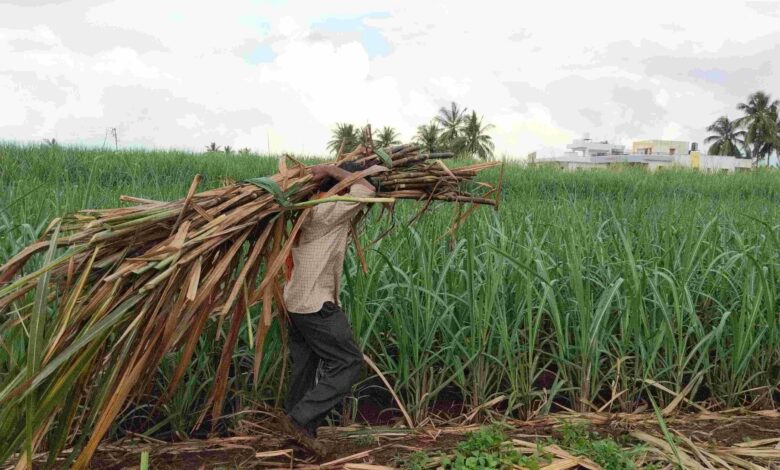From farms to mills, it’s a long wait for Western UP farmers just to get sugarcane weighed

As thousands of farmers lay siege to Delhi borders for over 100 days
demanding the repeal of three contentious farm laws, those staying back
in Western Uttar Pradesh have to endure a different kind of long wait —
at times for multiple days just to get weighed quintals of sugarcane
lying in tractor-trollies on their way from farms to mills.
Some pass their time chit-chatting about the ongoing protests, others
while smoking bidis or cigarettes, but all of them sound worried about
loads of sugarcane drying under a scorching sun, while Punjabi and
Haryanvi songs continue to blare out loudly, either from their mobiles
or small speakers fitted in their vehicles.
Also, problems for them are much more beyond the three laws that have
been in limelight due to the protests at the national capital borders.
Almost a hundred tractor-trollies, each loaded with 300 quintals of
sugarcane on an average, can be seen parked in a barren field near the
Bhopada weighing scale in Budhana tehsil here, barely two kilometres
from the Dhampur sugar mill — the final destination of the load and
their carriers after a days-long ‘weighing’ halt.
Some drivers, many of them farmers with small landholdings, even have
arrangements made for sleeping on cots fitted under their ‘trollas’
(customised and bigger trolleys used to transport sugarcane).
“It has been two days since I am waiting at this weighing scale and
looks like it will take me another two days for my work to be done so
that I can take my stock to the sugar mill,” Rohit Balyan, who hails
from Kutba village, told PTI.
“The exhausting long wait at weighing scales hurts farmers because the
sugarcane load starts drying up under the sun and by the time one’s turn
comes for measurement, the weight comes down a bit, the 21-year-old
Balyan said while lighting up a cigarette borrowed from a friend waiting
next in the queue.
A sugar mill official in Muzaffarnagar, which is widely known as the
‘sugar bowl’ of India and also has Asia’s larges gur mandi (jaggery
market), told PTI the weight loss during the waiting time is only a few
kilogrammes, but farmers argue this loss means a lot to them because
their earnings go down by thousands of rupees.
Farmers also claim that sugar mills are procuring sugarcane at Rs 325
per quintal, lower than the government-fixed minimum support price (MSP)
of Rs 385.
“We are not getting the MSP and then we have to wait here for days at
the weighing scale. The sugarcane starts drying up after a couple of
days and this means a reduction in weight and money for us,” said Anuj
Tomar, who hails from Kakda village.
Tomar, 25, said he has been standing in the queue for days with
sugarcane produced in his family’s 27-bigha land.
Among those waiting at the weighing scale are also people who do not own
land but are engaged in transporting sugarcane from farms to sugar mills
after getting the yield measures at weighing scales.
For them also, the loss of time during a peak work season means loss of
money.
Harsoli village resident Mukeem, 35, said he uses his tractor-trolla for
the transport work like many others in the region, who are typically
paid nearly Rs 12 per quintal of sugarcane from the mills.
“It has been three days since I am standing here. I have got more than
300 quintals of sugarcane loaded on my trolla. If we get it measured
quickly, then I can do more rounds and make more money,” Mukeem said.
He is also upset over an order of the National Green Tribunal (NGT) that
calls for phasing out old tractors in the National Capital Region (NCR).
Muzaffarnagar, which thrives on sugarcane production, is among the areas
affected by this order.
“How are we supposed to phase out our tractors just because they are 15
or 20-years old. They are working fine for us. The price of diesel has
gone up sharply in the last 10 years. The rate we get for transportation
is still the same but nobody is bothered about these issues, he said.
Also waiting for two days at the weighing scale are Raju Tyagi, 23, from
Osika village and 23-years-old Saleem from Kethal village, both of whom
strongly support protesting farmers’ demand for a legal guarantee on the
MSP and repeal of the three contentious agr
iculture laws.
Transporting sugarcane is a seasonal work both Tyagi and Saleem take up
and are mightily upset over the long delays at weighing scales.
“I hope that one day the government will consider our issues also,”
Saleem said.
According to the Muzaffarnagar administration estimates, more than 40
per cent of the district’s population is engaged in agriculture with
sugarcane farming topping the chart.
Sugar mill officials say much of the problem related to sugarcane
farming in the region is due to the surplus yield of sugarcane and the
limited production capacity of the mills.
“There are eight sugar mills in Muzaffarnagar alone. The one in Khatauli
is the biggest in Western Uttar Pradesh and has a purchasing capacity of
1,30,000 quintals a day,” a sugar mill official said, requesting anonymity.
“Farmers in the region mostly grow sugarcane and wheat. While wheat is
mostly grown for personal consumption, they sell sugarcane to mills
because of the MSP on it. That leads to sugar being in surplus, which in
turn results in various problems related to it,” the official said.
A measure to check these problems can only be policy-driven by the
government, the official suggested, adding there should be an upper
limit for farming of sugarcane.
“Farmers here are growing sugarcane on 90 per cent of their lands. If
that is reduced to say, 60 per cent, and farmers are asked to grow other
crops also, then a solution could be in sight,” he told PTI.




